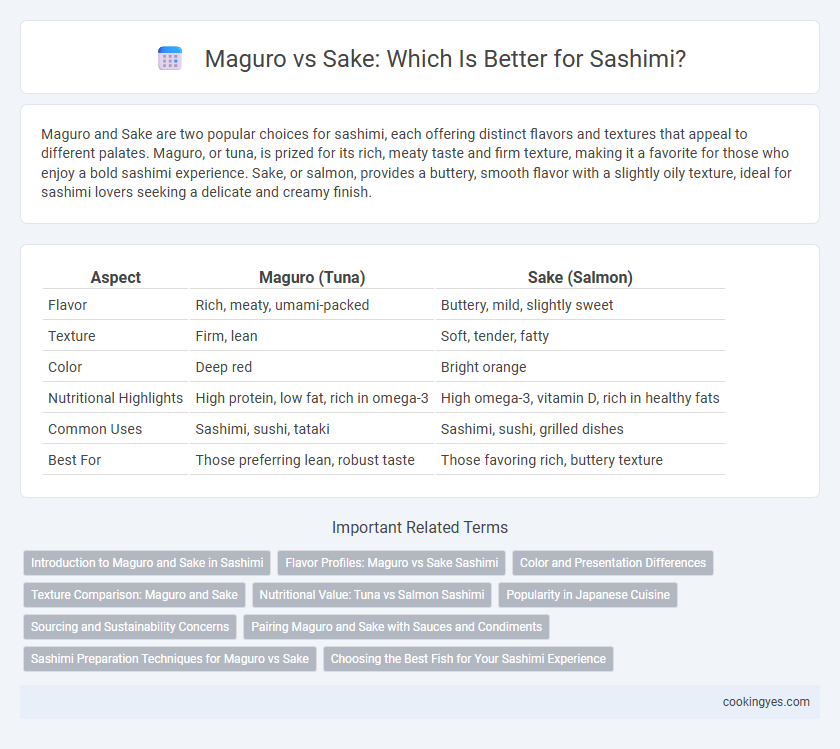Maguro and Sake are two popular choices for sashimi, each offering distinct flavors and textures that appeal to different palates. Maguro, or tuna, is prized for its rich, meaty taste and firm texture, making it a favorite for those who enjoy a bold sashimi experience. Sake, or salmon, provides a buttery, smooth flavor with a slightly oily texture, ideal for sashimi lovers seeking a delicate and creamy finish.
Table of Comparison
| Aspect | Maguro (Tuna) | Sake (Salmon) |
|---|---|---|
| Flavor | Rich, meaty, umami-packed | Buttery, mild, slightly sweet |
| Texture | Firm, lean | Soft, tender, fatty |
| Color | Deep red | Bright orange |
| Nutritional Highlights | High protein, low fat, rich in omega-3 | High omega-3, vitamin D, rich in healthy fats |
| Common Uses | Sashimi, sushi, tataki | Sashimi, sushi, grilled dishes |
| Best For | Those preferring lean, robust taste | Those favoring rich, buttery texture |
Introduction to Maguro and Sake in Sashimi
Maguro, or bluefin tuna, is prized in sashimi for its rich, meaty texture and deep umami flavor, often presented in various cuts like akami, chutoro, and otoro, which differ in fat content and taste intensity. Sake, or salmon, offers a buttery, mild flavor with a softer texture and vibrant orange color, making it a visually appealing and approachable choice for sashimi beginners. Both Maguro and Sake provide distinct taste profiles and nutritional benefits, with Maguro rich in protein and omega-3 fatty acids, while Sake provides high-quality protein and essential vitamins.
Flavor Profiles: Maguro vs Sake Sashimi
Maguro sashimi features a rich, meaty flavor with a firm texture and subtle umami notes, making it a favorite for those who enjoy a robust seafood taste. Sake sashimi, on the other hand, offers a delicate, buttery flavor with a smooth, tender texture and mild sweetness that appeals to fans of lighter, more subtle sashimi varieties. The contrast between Maguro's savory depth and Sake's gentle creaminess defines the distinct flavor profiles that sashimi enthusiasts appreciate.
Color and Presentation Differences
Maguro sashimi, made from tuna, boasts a deep red color that provides a rich, bold appearance on the plate, contrasting sharply with the pale pink to orange hues of Sake sashimi, which is crafted from salmon. The vibrant red of Maguro highlights its lean texture and is often presented in thicker slices to emphasize its meaty quality, while Sake sashimi's marbled fat gives it a silky texture and a more delicate, translucent presentation. These color and texture differences make Maguro ideal for striking, minimalist plating, whereas Sake is frequently accompanied by garnishes that enhance its soft, buttery visual appeal.
Texture Comparison: Maguro and Sake
Maguro sashimi features a firm, meaty texture with a slight chewiness, offering a satisfying bite that highlights its lean flesh. In contrast, Sake sashimi is renowned for its silky, buttery texture, melting smoothly on the palate due to its higher fat content. The texture difference between Maguro and Sake sashimi provides a distinct sensory experience, catering to varied preferences in raw fish enjoyment.
Nutritional Value: Tuna vs Salmon Sashimi
Tuna sashimi (Maguro) is rich in lean protein and contains high levels of omega-3 fatty acids, vitamin B12, and selenium, making it beneficial for heart health and muscle maintenance. Salmon sashimi (Sake) offers higher omega-3 content with substantial amounts of vitamin D and astaxanthin, a powerful antioxidant promoting skin and eye health. Both provide essential nutrients, but salmon delivers more fat-soluble vitamins while tuna offers a lower-calorie, high-protein option.
Popularity in Japanese Cuisine
Maguro (tuna) ranks as the most popular choice for sashimi in Japanese cuisine, prized for its rich flavor and versatile cuts ranging from lean akami to fatty otoro. Sake (salmon) has gained significant popularity due to its buttery texture and vibrant color, appealing to a broad audience including those new to raw fish. Market demand and seasonal availability influence the preference, with maguro maintaining a strong traditional status while sake continues to rise in contemporary sushi bars.
Sourcing and Sustainability Concerns
Maguro (tuna) sourcing faces significant sustainability challenges due to overfishing and high global demand, raising concerns about stock depletion and environmental impact. Sake (salmon) sashimi, often sourced from farmed Atlantic salmon or wild Pacific salmon, offers more sustainable options when certified by organizations like MSC or ASC, emphasizing responsible aquaculture and wild fisheries management. Consumers prioritizing sustainability should seek traceability and certifications to support ethical sashimi choices.
Pairing Maguro and Sake with Sauces and Condiments
Maguro sashimi, with its rich, umami-packed flavor and firm texture, pairs exceptionally well with soy sauce enhanced by wasabi, which amplifies its deep, meaty taste. Sake's clean, slightly sweet profile complements the subtle flavors of Maguro, especially when enjoyed alongside pickled ginger that refreshes the palate between bites. Combining Maguro sashimi with a dry, crisp sake and traditionally fermented soy sauce creates a balanced flavor experience that highlights the fish's natural richness and texture.
Sashimi Preparation Techniques for Maguro vs Sake
Maguro sashimi requires precise cutting techniques to highlight its firm texture and deep red color, often sliced into thicker pieces to maintain its richWei . Sake sashimi demands softer, more delicate slicing to preserve its tender, flaky quality and vibrant orange hue. Both types benefit from chilled preparation and sharp knives to ensure clean cuts that enhance their unique flavors and mouthfeel.
Choosing the Best Fish for Your Sashimi Experience
Maguro, or tuna, offers a rich, meaty texture with a deep umami flavor that makes it a favorite for sashimi lovers seeking intensity. Sake, or salmon, provides a buttery, delicate taste with a smooth, fatty consistency that appeals to those preferring a milder, softer flavor. Selecting the best fish for sashimi depends on personal preference for boldness versus subtlety, with maguro excelling in firmness and savoriness, while sake stands out for its creamy texture and gentle sweetness.
Maguro vs Sake for Sashimi Infographic

 cookingyes.com
cookingyes.com